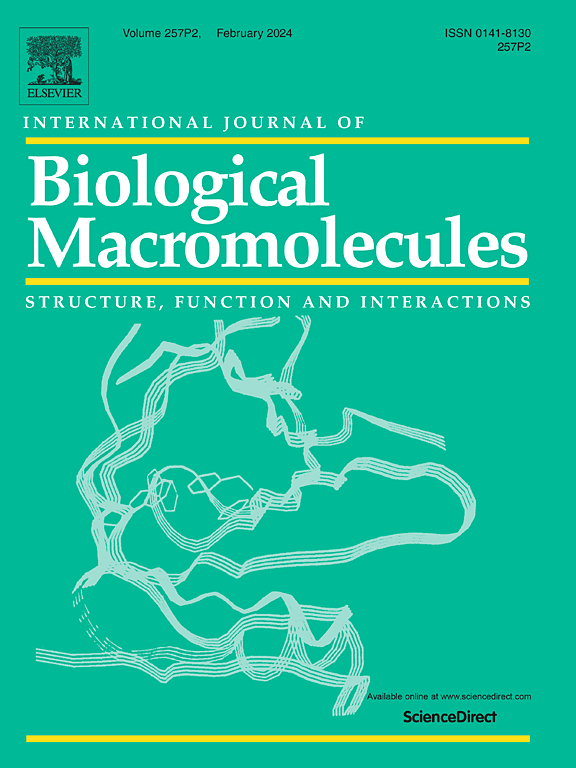用于生态友好和生物相容性化妆品的富含木质纤维素的核桃壳碳氢化合物:产品稳定性和微生物保护的可持续策略
IF 8.5
1区 化学
Q1 BIOCHEMISTRY & MOLECULAR BIOLOGY
International Journal of Biological Macromolecules
Pub Date : 2025-06-17
DOI:10.1016/j.ijbiomac.2025.145331
引用次数: 0
摘要
本研究探讨了从废核桃壳(WHC)中通过水热碳化(HTC)得到的水炭(HC)在化妆品中的应用潜力。将WHCs以不同浓度加入洁面凝胶和肥皂中,并评估其物理化学和抗菌性能。对微生物活性进行了广泛的测试:在25°C和45°C条件下,浓度为0.5%的WHC在30天内完全抑制了细菌和真菌的生长,对大肠杆菌(E. coli)和金黄色葡萄球菌(S. aureus)的抑制率降低了5%。微生物挑战试验证实,当WHC水平≥0.5%时,没有明显的菌落形成(估计为102 CFU/mL),而对照样品为106 CFU/mL。WHCs的加入也使肥皂的含水量从对照的14.4%降低到1% WHCs时的11.1%,提高了产品的稳定性。此外,含whc凝胶配方的pH值保持在皮肤相容性范围内(5.56-5.85),凝胶中的泡沫高度从350 mL增加到500 mL,肥皂中的泡沫高度从12 mL增加到17 mL,表明性能有所提高。GC-MS和FT-IR分析鉴定出49种生物活性化合物,包括酚类、醛类和有机酸,有助于抗菌作用和稳定性。这些发现表明,WHC是一种可行的天然替代品,可以替代合成防腐剂和添加剂,支持开发更环保、更持久的化妆品配方。本文章由计算机程序翻译,如有差异,请以英文原文为准。

Lignocellulose-rich walnut shell hydrochars for eco-friendly and biocompatible cosmetics: A sustainable strategy for product stability and microbial protection
This study investigates the potential of hydrochars (HC) derived from waste walnut shells (WHC) through hydrothermal carbonization (HTC) for cosmetic applications. WHCs were incorporated into facial cleansing gels and soaps at varying concentrations, and their physicochemical and antimicrobial properties were evaluated. Microbial activity was extensively tested: WHC at a concentration of 0.5 % completely inhibited bacterial and fungal growth over a 30-day period at both 25 °C and 45 °C, achieving a log reduction of >5 against Escherichia coli (E. coli) and Staphylococcus aureus (S. aureus). Microbial challenge tests confirmed no visible colony formation (estimated <102 CFU/mL) at WHC levels ≥0.5 %, compared to >106 CFU/mL in control samples. The incorporation of WHCs also reduced the soap moisture content from 14.4 % in the control to 11.1 % at 1 % WHC, enhancing product stability. Furthermore, the pH of WHC-containing gel formulations remained within the skin-compatible range (5.56–5.85), and foam height increased from 350 mL to 500 mL in gels, and from 12 mL to 17 mL in soaps, indicating improved performance. GC–MS and FT-IR analyses identified 49 bioactive compounds, including phenolics, aldehydes, and organic acids, contributing to antimicrobial action and stability. These findings suggest WHC is a viable natural alternative to synthetic preservatives and additives, supporting the development of greener, longer-lasting cosmetic formulations.
求助全文
通过发布文献求助,成功后即可免费获取论文全文。
去求助
来源期刊
CiteScore
13.70
自引率
9.80%
发文量
2728
审稿时长
64 days
期刊介绍:
The International Journal of Biological Macromolecules is a well-established international journal dedicated to research on the chemical and biological aspects of natural macromolecules. Focusing on proteins, macromolecular carbohydrates, glycoproteins, proteoglycans, lignins, biological poly-acids, and nucleic acids, the journal presents the latest findings in molecular structure, properties, biological activities, interactions, modifications, and functional properties. Papers must offer new and novel insights, encompassing related model systems, structural conformational studies, theoretical developments, and analytical techniques. Each paper is required to primarily focus on at least one named biological macromolecule, reflected in the title, abstract, and text.

 求助内容:
求助内容: 应助结果提醒方式:
应助结果提醒方式:


